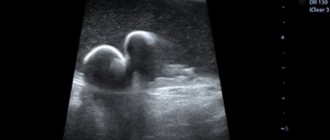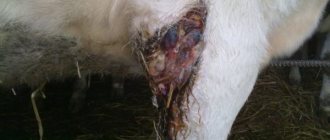Blepharitis is an inflammation of the eyelids. This disease is widespread in modern veterinary medicine. Inflammation is most often localized in the outer layer of the eyelid; in more severe cases, it can spread to the inner layer and conjunctiva.
The outer layer of the eyelid consists of: skin with hair follicles, connective tissue, muscles and meibomian glands.
In the article you will learn what blepharitis is, the main types, symptoms of the dog’s disease, how treatment occurs and what to do to prevent it.
Causes
There are many causes of blepharitis. Therefore, for convenience, they were divided into two broad groups: non-infectious and infectious blepharitis.
Non-infectious
The causes of non-infectious blepharitis are: congenital pathologies of the eyelids, the shape of the muzzle, allergic reactions, inflammatory processes, the appearance of malignant/benign neoplasms, mechanical/chemical damage to the eyelid and other factors.
Let's look at some of them in more detail:
- Congenital pathologies of the eyelids often cause blepharitis in an animal; such pathologies include: entropion of the eyelids, eversion of the eyelid margin, distichiasis (appearance of an additional row of eyelashes), trichiasis (pathological growth of eyelashes towards the eye).
- The shape of the muzzle can often be the cause of the disease. Dogs with a brachycephalic skull shape are most predisposed, i.e. flattened and shortened muzzle. Such animals, with rare exceptions, have a bulging eyeball, which can also be the cause of the disease.
- Allergic reactions, a common cause of this disease, can occur to an insect bite, to any medicine, to new food, food additives, and AR to dust or pollen is possible.
- Other provoking factors. This can include various diseases against which the disease develops - diabetes mellitus, Cushing's syndrome and other hormonal diseases, diseases of the endocrine system, disorders of the digestive tract.
Infectious
This is an inflammation of the eyelids due to the action of microorganisms such as bacteria, fungi, and mites on the body.
Bacterial (marginal) is the most common type of infectious blepharitis. The main cause is staphylococcal or streptococcal infections, which cause eyelid disease.
Marginal blepharitis can be primary (bacteria are localized directly on the eye and around the eyeball) or secondary (bacteria are not located in the eyes, but in the immediate vicinity - in the ears, mouth, on the skin). With this pathology, diffuse abscesses may appear, which are quite difficult to treat.
Bacterial blepharitis is not always an independent disease, but can appear as a complication of an existing pathology, for example juvenile pyodermatitis.
Tick-borne (demodectic) blepharitis develops when the skin is damaged by parasitic diseases. Most often occurs with demodicosis, notoedrosis, and red scabies.
Fungal (mycosis of the eyelids) is less common than bacterial or tick-borne. The causes of mycosis of the eyelids are long-term antibiotic therapy, excessive use of corticosteroids, and autoimmune diseases. This type of blepharitis is difficult to diagnose and very difficult to cure.
Lens luxation
Lens luxation is a partial or complete displacement of it from the hyaloid canal, where it is normally located. After a ligament rupture, the pupil becomes deformed and moves to the side, and the eyeball may also become deformed.
Dislocation occurs due to genetic predisposition, as well as as a complication of infections and injuries, glaucoma and cataracts. It often leads to complete loss of vision, and is therefore considered a very serious disease.
Types of blepharitis
Veterinarians distinguish 4 main forms of the disease:
- Scaly (the second name is a simple form). It manifests itself as thickening of the edges of the eyelids, their hyperemia, and the formation of characteristic grayish scales at the base of the eyelashes.
- Ulcerative. A form of the disease accompanied by the discharge of pus. The pus dries and forms scabs (crusts), after their removal ulcers form. Eyelashes fall out, itching and pain are observed. After complete healing, scars form that interfere with the proper growth of eyelashes.
- Meibomian. A form of blepharitis, which is characterized by a pathologically large secretion. Fluid enters the conjunctival cavity, which causes inflammation. Possible complication of purulent infection.
- Furunculous (phlegmous) form or barley. The appearance of small ulcers throughout the eyelid, which will soon open. May cause complications - sepsis.
Uveitis
With uveitis, inflammation of the iris and choroid occurs. This is a rather dangerous disease that can be found in all breeds. With uveitis, the dog's eye first becomes inflamed, followed by photophobia and a sharp decrease in vision. The animal can hardly open its affected eye and tries to hide in the darkness.
Uveitis can occur as a result of infection, bacterial or viral infection, keratitis, trauma, or may be a complication of internal inflammatory diseases.
Only a doctor can diagnose pathology. In its advanced form, uveitis can lead not only to blindness, but also to loss of the eye, which is why it is important to seek help from a specialist in a timely manner.
Symptoms
Each form of blepharitis has a number of characteristic symptoms, they are described above. But there are certain signs that are characteristic of all forms of the disease. These signs include:
- swelling and hyperemia of the eyelids;
- itching and burning;
- fear of light;
- severe lacrimation;
- thickening of the eyelids.
Sometimes you can observe a symptom such as blepharospasm - an involuntary spastic and repeated contraction of the circular muscles of the eye.
Third eyelid prolapse
Third eyelid prolapse is often called “cherry eye.” The eyeball becomes very swollen and red, the third eyelid loses its tone and protrudes from the edge of the eye. Prolapse rarely occurs in both eyes; more often it affects only one eyelid. The main cause of this disease is infection, although hereditary factors are also common. Third eyelid prolapse most often occurs in bulldogs, spaniels and beagles.
Due to prolapse, the mucous membranes dry out, which can lead to problems with the cornea and conjunctiva. Loss can only be corrected surgically. Before surgery, the dog is prescribed moisturizing eye drops.
Treatment
Diagnosis in dogs
The veterinarian performs an eye examination to determine the extent of eyelid damage. To accurately determine the type of infectious blepharitis (bacterial, tick-borne, fungal), an ophthalmological examination is used.
If a non-infectious infection is suspected, which is caused by an allergy, a series of tests will be required to determine the affecting allergen.
In the case of tumor formation, a biopsy is required to determine the nature of the tumor and prescribe appropriate treatment. If there is no apparent cause for the development of blepharitis, blood is taken for analysis to determine the source of the problem.
First aid
If the owner discovers signs of inflammation of the eyelids in his pet, the first thing to do is to put a protective collar on the dog to prevent injuries that the dog will inflict on itself while trying to scratch the irritated area.
The second thing that can be done for the animal is to treat the eyelid with physical. solution or 0.05% chlorhexidine solution.
IT IS NOT RECOMMENDED to give your animal antibiotics or immunosuppressive drugs yourself, because this can harm and distort the clinical picture, making diagnosis difficult.
How and with what to treat?
A lot depends on the choice of the right treatment - the speed of the dog’s recovery, the absence of consequences and even monetary costs. It is important to immediately correctly diagnose and begin treatment of the causes of the disease, and not its symptoms. Treatment can be symptomatic or aimed at eliminating the causes.
Symptomatic treatment (elimination of symptoms):
- Cleaning the eyelids from purulent scales; to do this, they are soaked and carefully removed with a cotton pad (napkin), which is pre-moistened in saline solution or furatsilin.
- To eliminate the inflammatory process, an anti-inflammatory ointment (erythromycin, Zovirax, Tobradex) is applied to the eyelid.
The main treatment , which is aimed at eliminating the cause, is chosen depending on the cause of the disease.
- Infectious. Treatment is with antibiotics and sulfonamides. Ointments - tetracycline, colbiocin; eye drops Albucid with sodium sulfacyl, etc.
- Kleshchevoy. Anti-tick drugs (Metronidazole) are used.
- Allergic. Its treatment consists of eliminating the effect of the allergic factor; at the discretion of the doctor, antihistamines may be prescribed.
- In case of a tumor or congenital pathology of the eyelids, the problem is solved with the help of surgery.
IMPORTANT! Treatment without knowing the exact cause can lead to a worsening of the animal's condition. Do not self-medicate.
Treatment at home
Often, dogs are treated at home. The owner should remove all discharge from the eyes several times a day; for this, you can use ordinary clean boiled water (room temperature), medicinal herbal decoctions - calendula and chamomile are good because. they are excellent at relieving inflammation.
It is possible to use salt compresses to remove pus (it is important that the solution does not get into the eyes!). After the compress, carefully remove the crusts, and treat the ulcer with iodine solution or brilliant green, but so that these solutions do not get on the mucous membrane of the eye or conjunctiva (this can cause burns).
Keratitis
Inflammation of the cornea of the eye. Occurs as a result of exposure to various factors. Sometimes it is a consequence of conjunctivitis.
According to its form, keratitis is divided into ulcerative and deep. According to the symptoms of this eye disease in dogs, one can observe blepharospasm, increased lacrimation, purulent or hemorrhagic discharge, pain, increased vascularization of the cornea, its clouding, and the appearance of ulcerations. Treatment must be carried out as quickly as possible and taking into account both the severity and etiological factors.
Among other things, it is worth highlighting breed-specific diseases of the cornea of dogs, manifested by keratitis.
Shepherd keratitis
Occurs after the age of 24 months and has a hereditary predisposition. This disease manifests itself as chronic superficial keratitis, which is characterized by gray-white turbidity and the formation of a red granulation shaft. In addition to eye damage, this pathology may cause ulceration of the inner corner of the eye fissure, pemphigus and prolapse of the third eyelid.
Treatment includes the use of eye ointments with the hormone, but it is temporary and should stop the manifestations of the disease and the period of relapses.
Dachshund keratitis
This is also a disease of autoimmune origin, however, some researchers associate its occurrence with the presence of the herpes virus in the dog’s body. Meanwhile, this hypothesis still does not have a sufficient evidence base.
The disease occurs in several stages, each of which has its own characteristics. At the first stage, local irritation and spot opacities are observed. In the second, superficial vascularization of the cornea and pannus formation are additionally diagnosed. At the third stage, the cornea becomes gray-pink and loses transparency.
Ointments and drops containing glucocorticoids and antibiotics are also used as treatment.
Prevention
Prevention of such a disease does not require any effort, but consists of a properly formulated, complete diet, regular active walks in the fresh air, proper rest, timely treatment of the inflammatory process, and maintaining the dog’s health with regular treatments for helminth infections and skin parasites.
It is also necessary to monitor the hygiene of the dog’s sleeping place and its utensils. At the first signs of illness, contact a veterinary clinic.
In the absence of proper treatment or repeated relapses, the dog's vision deteriorates.
Classification of eye diseases
Eye diseases in dogs can occur either independently (primary pathology) or as a complication of any disease, most often provoked by an infectious agent (secondary pathology).
Some pet owners become very frightened when a white, cloudy film (a cataract or leukoma) appears on their pet's eye. Many reasons can provoke the appearance of a cloudy spot, but most often an eyesore in a dog appears as a result of:
- tumors growing in the eyeball;
- age-related changes (elderly dogs);
- autoimmune diseases;
- congenital pathologies (non-closing eyelid);
- diseases leading to disorders and inflammatory processes in the tissue of the eyeball;
- entropion of the eyelid;
- injuries resulting in the formation of ulcers on the cornea of the eye;
- unsuccessful surgery;
- exposure to various poisons and chemicals on the organs of vision.
Eye diseases often require a mandatory examination by a veterinarian, since the risk of severe and irreversible consequences is very high, up to and including complete blindness of the dog.
Briefly about the main thing
- Blepharitis is an inflammation of the eyelids, which, if treated incorrectly or untimely, can cause a dog’s vision to deteriorate sharply.
- The disease can be infectious or non-infectious.
- The furunculous form of blepharitis is dangerous because... can cause serious complications - sepsis.
- The most vulnerable are brachycephalic dogs and dogs with a narrow and long muzzle.
- Self-treatment with antibiotics can harm the animal.
- Treating the symptoms will “eliminate” the disease in the short term; the cause must be addressed.
- For prevention, the general condition of the animal should be maintained and deworming/treatment for skin parasites should be carried out in a timely manner.
How to cure blepharitis in dogs in time and avoid complications?
It is more often possible to free your pet from eye disease by using bactericidal substances and drugs that relieve inflammation. When the disease is associated with a congenital abnormal structure of the eyelid, a conventional operation is performed. If the inflammation is caused by an allergy, contact with the allergen should be eliminated for treatment. In any case, blepharitis can be treated well with the right approach. The dog owner must take the dog to the clinic in a timely manner and follow all the veterinarian’s recommendations for treatment.
Diagnosis of meibomite
During the examination, the doctor must determine the cause of the disease. The method of treatment and the type of medications that will be used depend on it. So, for bacterial etiology, antibiotics and antibacterial agents are prescribed, for fungal infections of the eyelids, antifungal drops and ointments are used, etc. The following methods allow you to make an accurate diagnosis:
- microscopic and cultural studies of secretions;
- scraping analysis;
- slit lamp biomicroscopy;
- allergy tests;
- examination of eyelashes for demodicosis.
Physiotherapy for meibomitis
Positive dynamics are observed in the treatment of inflammation using hardware methods. As a rule, a course of UHF therapy or ultraviolet irradiation aimed at the eyelids is prescribed. In recent years, procedures such as:
- Helium-neon laser stimulation. Therapy using laser technology has analgesic, anti-inflammatory and regenerative effects. Opened ulcers heal faster. The risk of complications is reduced.
- Magnetotherapy. Magnetic fields directed to the eyelids by a special device help restore natural biorhythms in the tissues, normalizing their condition. After just a few sessions, the functionality of the meibomian glands improves.











